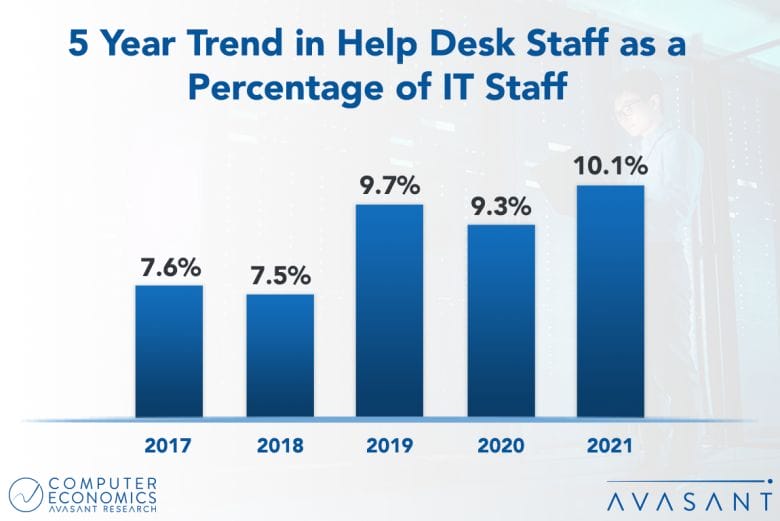The help desk role should never be overlooked; it is more important than ever. It is the face of IT for the business. And, as businesses maneuver to adapt to new working environments—work from anywhere—help desk technicians take on a strategic imperative. The help desk is continuing to constitute a larger share of the IT staff.
In 2021, the help desk staffing ratio took another jump, albeit small, surpassing the 2019 ratio. As shown in Figure 1 from our full report, Help Desk Staffing Ratios, the ranks of help desk personnel expanded during the past year, reaching 10.1% of the total IT head count at the median, up from 9.3% in 2020 and 9.7% in 2019.

The COVID-19 pandemic has re-emphasized the importance of help desk technicians. Due to lockdowns, many companies were forced to move their teams to working primarily from home, sometimes literally overnight. As such, remote issues became a staple in any working environment. But remote issues are often more time-consuming, because they are heavily dependent on end-user skills and cooperation. The help desk staff was at the forefront of a major shift in the way we work, and will continue to be so as we shift to a hybrid work environment, where employees will be expected to work anywhere seamlessly.
The role of the help desk will continue to expand. Companies are using a greater variety of business applications, which puts increasing demands on the help desk. And, as we have been reporting, the more companies automate routine business processes, the more people skills matter, and the more experience matters. As a result, the help desk becomes the front line for the IT organization in showing its worth to the user community.
However, in the future, there are a few factors that may reduce the demand for help desk staff. One such factor is the use of remote management systems. Self-diagnostics, self-healing, and self-support systems promise to further control the cost of help desk support.
“With all the options for automation and self-service, you’d expect the number of help desk staff to be declining,” said Tracell Frederick, research analyst/editor for Computer Economics, a service of Avasant Research, based in Los Angeles. “However, the opposite is happening. The tools aren’t being used to cut staff but to help them spend their time on more value-added activities.”
The full report provides metrics for benchmarking help desk staffing levels in the current environment. We look at the trend in help desk staffing over a five-year period and provide four benchmarks by organization size and sector: help desk staff as a percentage of the IT staff, users per help desk staff member, applications per help desk staff member, and first-call resolution rates. Because companies organize the end-user support function in different ways, we also provide benchmarks for a combined help desk and desktop support staff. We conclude with recommendations on optimizing help desk staffing levels.
This Research Byte is a brief overview of our report on this subject, Help Desk Staffing Ratios. The full report is available at no charge for Computer Economics subscribers, or it may be purchased by non-subscribers directly from our website (click for pricing)





